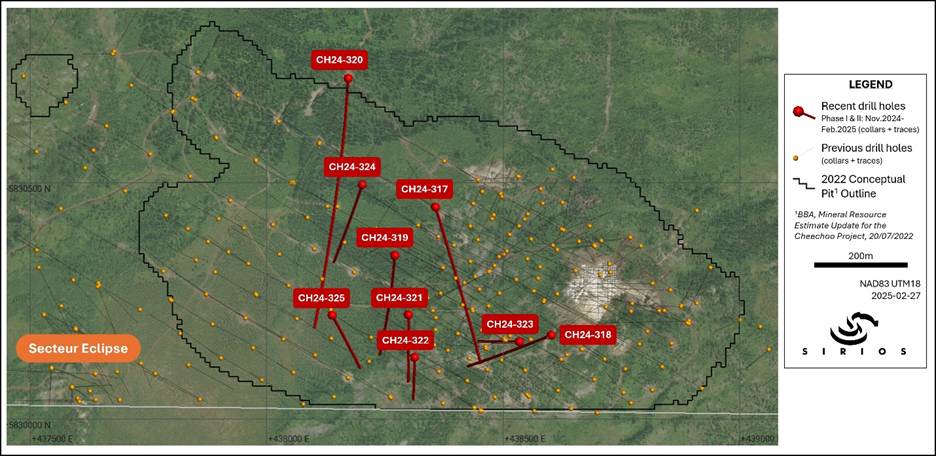Overview
Located less than 15 km from Dhilmar’s Éléonore gold mine in the Eeyou Istchee James Bay territory of Québec, the Cheechoo property, 100% owned by Sirios, contains an untapped gold deposit with excellent expansion and development potential, for both large-volume open-pit extraction and high-grade underground mining.
Open-pit potential
Source: BBA, Mineral Resource Estimate Update for the Cheechoo Project, 23/12/2022
Underground potential
The Cheechoo Gold Deposit
The Cheechoo Project contains multiple gold-enriched zones encased in a lower-grade halo. The deposit is hosted in a folded tonalite intrusion surrounded by metasedimentary rocks similar to those hosting the Éléonore mine.
Sections of the Eclipse High-Grade Zone
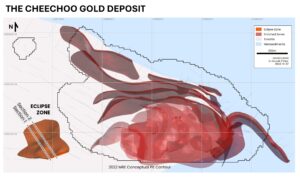
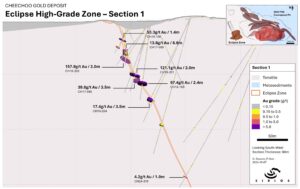
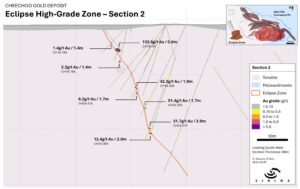
Potential high-grade zones
Numerous high-grade gold intercepts suggest the occurrence of higher-grade zones throughout the deposit:
| Au (g/t) | Length (m) | From (m) | To (m) | Drill hole | Zone |
|---|---|---|---|---|---|
| 30.1 | 8.0 | 317.2 | 325.2 | CH17-112 | Outside* |
| 30.4 | 7.1 | 130.5 | 137.6 | CH16-052 | Outside* |
| 9.5 | 16.8 | 132.5 | 149.3 | CH16-041 | Outside* |
| 21.5 | 7.0 | 74.0 | 81.0 | CH16-035 | Outside* |
| 8.8 | 16.3 | 21.1 | 37.4 | CH21-280 | Outside* |
| 31.3 | 4.6 | 162.3 | 166.9 | CH21-295 | Outside* |
| 65.1 | 2.1 | 99.5 | 101.6 | CH17-095 | Eclipse Zone |
| 9.7 | 14.0 | 125.0 | 139.0 | CH17-112 | Outside* |
| 27.5 | 4.8 | 82.2 | 87.0 | CH19-245 | Outside* |
| 41.3 | 3.1 | 17.5 | 20.6 | CHRN17-213 | Outside* |
| 13.8 | 9.0 | 270.5 | 279.5 | CH20-265 | Outside* |
| 15.8 | 7.4 | 110.0 | 117.4 | CH21-285 | Outside* |
| 26.6 | 4.3 | 115.5 | 119.9 | CH15-020 | Outside* |
| 55.7 | 2.0 | 64.0 | 66.0 | CH19-202 | Eclipse Zone |
| 12.2 | 9.1 | 85.0 | 94.1 | CH18-191 | Outside* |
| 21.2 | 5.2 | 562.5 | 567.7 | CH17-108 | Outside* |
| 11.3 | 9.5 | 38.0 | 47.5 | CH15-028 | Outside* |
| 22.7 | 4.6 | 213.9 | 218.5 | CH20-266 | Outside* |
| 15.3 | 6.8 | 336.0 | 342.8 | CH19-240 | Outside* |
| 12.9 | 8.0 | 294.0 | 302.0 | CH17-132 | Outside* |
| 26.4 | 3.9 | 143.6 | 147.5 | CH18-184 | Outside* |
| 28.4 | 3.6 | 62.5 | 66.1 | CH16-086 | Outside* |
| 34.1 | 3.0 | 425.0 | 428.0 | CH17-098 | Outside* |
| 50.5 | 2.0 | 77.5 | 79.5 | CH19-201 | Eclipse Zone |
| 24.0 | 4.2 | 32.0 | 36.2 | CH16-079 | Outside* |
| 10.0 | 9.9 | 57.6 | 67.5 | CH18-182 | Outside* |
| 17.1 | 5.8 | 228.1 | 233.9 | CH17-125 | Outside* |
| 7.0 | 13.8 | 19.1 | 32.9 | CH21-279 | Outside* |
| 11.7 | 8.0 | 105.0 | 113.0 | CHRC21-002 | Outside* |
| 37.3 | 2.5 | 440.7 | 443.2 | CH18-125E | Outside* |
| 18.8 | 4.9 | 202.5 | 207.4 | CH18-183 | Outside* |
| 24.0 | 3.8 | 152.0 | 155.8 | CH17-134 | Outside* |
| 28.3 | 3.2 | 59.1 | 62.3 | CH18-159 | Outside* |
| 18.9 | 4.6 | 59.5 | 64.1 | CH15-020 | Outside* |
| 17.5 | 4.9 | 253.0 | 257.9 | CH24-305 | Eclipse Zone |
| 5.2 | 16.2 | 174.9 | 191.1 | CH15-024 | Outside* |
| 11.8 | 7.0 | 121.5 | 128.5 | CH18-191 | Outside* |
| 34.2 | 2.4 | 90.0 | 92.4 | CH18-163 | Eclipse Zone |
| 37.1 | 2.2 | 91.8 | 94.0 | CH18-161 | Eclipse Zone |
| 16.2 | 5.0 | 280.5 | 285.5 | CH20-258 | Outside* |
| 15.8 | 5.0 | 261.0 | 266.0 | CH16-058E | Outside* |
| 9.6 | 8.2 | 221.3 | 229.5 | CH17-139 | Outside* |
| 27.8 | 2.8 | 156.6 | 159.4 | CH17-112 | Outside* |
| 17.0 | 4.5 | 25.8 | 30.3 | CH19-199 | Eclipse Zone |
| 18.0 | 4.2 | 104.8 | 109.0 | CH21-283 | Outside* |
| 18.8 | 4.0 | 117.5 | 121.5 | CH16-088 | Outside* |
| 11.8 | 6.3 | 130.0 | 136.3 | CH16-088 | Outside* |
| 13.1 | 5.5 | 96.1 | 101.6 | CH18-176 | Outside* |
| 12.8 | 5.5 | 138.5 | 144.0 | CH14-017 | Outside* |
| 5.0 | 14.1 | 322.6 | 336.7 | CH18-181 | Outside* |
| 3.4 | 19.7 | 258.1 | 277.8 | CH17-122 | Outside* |
| 30.1 | 2.2 | 125.8 | 128.0 | CH17-124 | Outside* |
| 25.6 | 2.4 | 36.8 | 39.2 | CH18-192 | Outside* |
| 13.1 | 4.6 | 107.3 | 111.9 | CH16-065 | Outside* |
| 30.2 | 2.0 | 137.5 | 139.5 | CH19-204 | Eclipse Zone |
| 15.1 | 4.0 | 325.0 | 329.0 | CH17-111 | Outside* |
| 18.7 | 3.2 | 232.0 | 235.2 | CH21-288 | Outside* |
| 14.7 | 3.9 | 55.0 | 58.9 | CH15-026 | Outside* |
| 24.8 | 2.3 | 189.2 | 191.5 | CH21-296 | Outside* |
| 18.9 | 3.0 | 123.0 | 126.0 | CH18-196 | Outside* |
| 22.9 | 2.4 | 7.3 | 9.7 | CH17-119 | Outside* |
| 14.7 | 3.7 | 137.0 | 140.7 | CH17-128 | Outside* |
| 12.8 | 4.2 | 82.7 | 86.9 | CH16-054 | Outside* |
| 21.3 | 2.5 | 323.0 | 325.5 | CH17-109 | Outside* |
| 25.8 | 2.0 | 44.7 | 46.7 | CH17-099 | Eclipse Zone |
| 9.0 | 5.6 | 213.5 | 219.0 | CH13-010 | Outside* |
| 13.7 | 3.6 | 37.3 | 40.9 | CH18-182 | Outside* |
| 10.6 | 4.5 | 214.0 | 218.5 | CH17-128 | Outside* |
| 6.3 | 7.5 | 152.5 | 160.0 | CH17-123 | Outside* |
| 7.8 | 6.0 | 134.5 | 140.5 | CH17-098 | Outside* |
| 16.1 | 2.5 | 173.4 | 175.9 | CH21-274 | Outside* |
| 7.7 | 4.7 | 278.1 | 282.8 | CH17-108 | Outside* |
| 5.4 | 6.7 | 58.3 | 65.0 | CH19-221 | Outside* |
| 7.1 | 5.0 | 111.0 | 116.0 | CH15-024 | Outside* |
| 13.3 | 2.5 | 130.6 | 133.1 | CH14-018 | Outside* |
| 7.1 | 4.4 | 305.6 | 310.0 | CH17-111 | Outside* |
| 9.8 | 3.0 | 367.0 | 370.0 | CH16-062 | Outside* |
| 11.0 | 2.6 | 25.5 | 28.1 | CH17-112 | Outside* |
*High-grade gold intercepts located outside the Eclipse zone
Next Phases of Development
“We are thrilled to launch this new vision for the Project. Cheechoo now presents dual potential: large-volume open-pit mining and/or high-grade underground development. This new outlook is a game changer for the Project, consequently leading our team to design an intensive drilling program targeting high-grade enriched zones.”
Planned drilling program
Sirios’ technical team is currently designing an intensive drilling program aimed at delineating high-grade zones within the property. The company intends to disclose comprehensive details about this strategic program in forthcoming press releases, offering stakeholders valuable insights into Sirios’ exploration plans and objectives.
Mineral Resource Estimate (MRE) Update
A Prime Location
The Cheechoo property is ideally located for mining development:
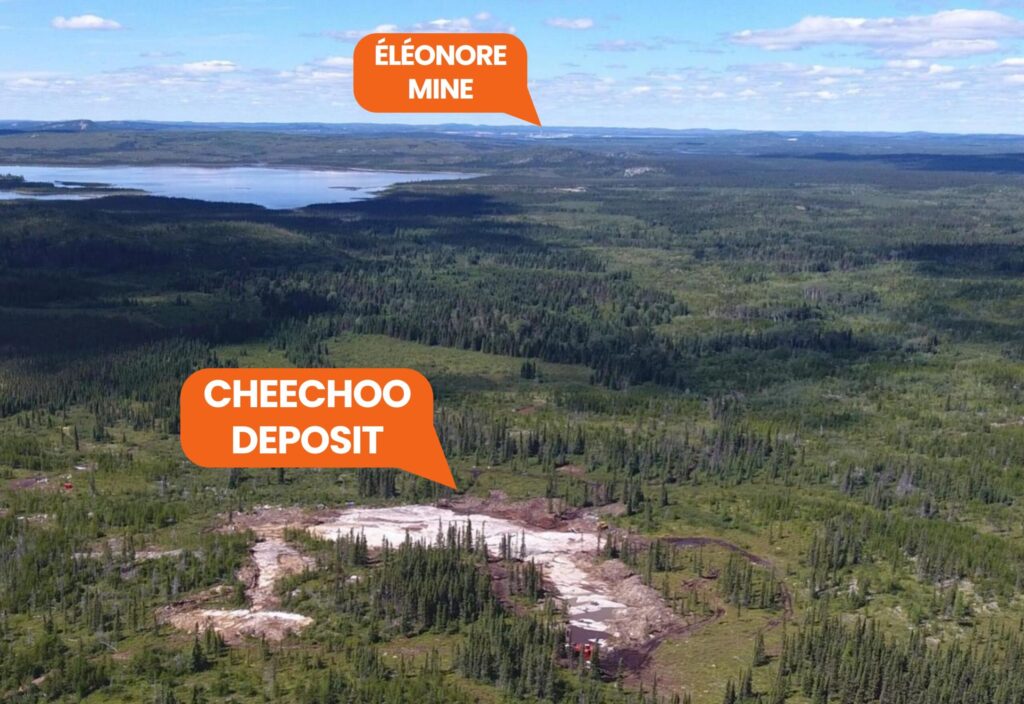
Discover Cheechoo and More on Our Project Portfolio Map.
Geological Setting
The Cheechoo property is located at the suture zone between two geological subprovinces: the Opinaca and La Grande. The Opinaca Subprovince contributes paragneissic wacke and migmatites, while the La Grande Subprovince provides banded iron formations and mafic dykes. The centerpiece of the property is the Cheechoo intrusion, dated at 2612 Ma, which is roughly contemporaneous with other granitic suites in the region.
Cheechoo Intrusion Characteristics
The Cheechoo intrusion displays variable textures, ranging from massive to gneissic, indicating a complex magmatic and metamorphic history. It has a granodioritic to trondhjemitic composition, with metaluminous to peraluminous tendencies and a reduced nature. The intrusion is notably high in sodium content, likely due to an early gold-related sodic metasomatic event.
Gold Mineralization
Gold mineralization is primarily hosted within the Cheechoo intrusion, with some occurrences in surrounding metasedimentary rocks, pegmatite dykes, and mafic schists. The mineralization is characterized by networks of quartz veins with associated calc-silicate and potassic alteration. High-grade gold veins typically contain less than 5% disseminated sulfides and often display visible gold.
Metallogenic Model
The structural characteristics of the gold system suggest a syn-tectonic emplacement of the Cheechoo intrusion and related gold-bearing vein networks. The mineralogy, alteration assemblages, and association with a reduced intrusion bear similarities to reduced intrusion-related gold systems. This represents a new style of gold mineralization in the Eeyou Istchee James Bay region.
Latest Updates on the Cheechoo Project
Cheechoo Gold Project: Mineral Resource Estimate Update Underway Based on New Model
Montréal (Québec) – Sirios Resources Inc. (TSX-V: SOI; OTCQB: SIREF) (“Sirios”) is pleased to announce…
Sirios to Host Livestream Detailing Cheechoo Gold Project Revamp on May 28
Montreal (Quebec) – Sirios Resources Inc. (TSX-V: SOI; OTCQB: SIREF) (“Sirios”) will host a livestream…
Sirios’ New Vision for Cheechoo Validated by Excellent Drill Results Including 13.5 g/t Au over 14.6 m
Montreal, QC – Sirios Resources Inc. (TSX-V: SOI; OTCQB: SIREF) (“Sirios” or the “Company”) is…
Visible Gold Observed in Extension of Drill Hole #317 at Cheechoo
Montreal, QC – Sirios Resources Inc. (TSX-V: SOI; OTCQB: SIREF) (“Sirios” or the “Company”) is…
Sirios obtains up to 40.7 g/t Au over 1.0 m in the last two holes of 2024 and resumes drilling at Cheechoo
Montréal, QC – Sirios Resources Inc. (TSX-V: SOI; OTCQB: SIREF) (“Sirios” or the “Company”) “)…
Sirios intersects up to 79.7 g/t Au over 1.4 m in the two first drill holes of Fall 2024 at Cheechoo
Montréal, QC – Sirios Resources Inc. (TSX-V: SOI; OTCQB: SIREF) (“Sirios” or the “Company”) is…






